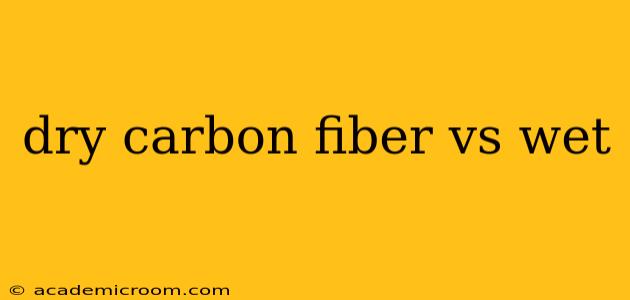Carbon fiber is a remarkable material, prized for its exceptional strength-to-weight ratio. However, the manufacturing process significantly impacts the final product's properties and cost. This comparison delves into the key differences between dry and wet carbon fiber layup techniques, helping you understand which is best suited for your needs.
What is Dry Carbon Fiber?
Dry carbon fiber uses prepreg (pre-impregnated) carbon fiber sheets that have a controlled amount of resin already applied. The resin is partially cured, allowing for easier handling and a more precise layup process. The excess resin is squeezed out during the curing process under pressure in an autoclave. This results in a lighter, stronger, and more consistent final product.
Advantages of Dry Carbon Fiber:
- Higher Strength-to-Weight Ratio: Because excess resin is removed, dry carbon fiber parts boast a superior strength-to-weight ratio compared to wet layup.
- Improved Mechanical Properties: The precise control over resin content leads to better mechanical properties, including increased stiffness and tensile strength.
- Better Surface Finish: The absence of excess resin often translates to a smoother, more aesthetically pleasing surface finish.
- Reduced Void Content: This meticulous process minimizes voids (air pockets) within the composite, enhancing its structural integrity.
Disadvantages of Dry Carbon Fiber:
- Higher Cost: The prepreg materials and specialized equipment (autoclave) required for curing significantly increase the overall cost.
- More Complex Process: The manufacturing process is more complex and requires skilled labor.
- Shelf Life Limitations: Prepreg materials have a limited shelf life, requiring careful inventory management.
What is Wet Carbon Fiber?
Wet carbon fiber uses dry carbon fiber fabric and resin that are mixed together during the layup process. The resin is added manually, which can introduce variability in resin content. Curing is typically done at lower pressures and temperatures than dry carbon fiber.
Advantages of Wet Carbon Fiber:
- Lower Cost: The materials and equipment required are less expensive than those needed for dry carbon fiber layup.
- Simpler Process: The layup process is simpler and requires less specialized equipment and skills.
- Greater Design Flexibility: Wet layup offers more flexibility in terms of design and part geometry.
Disadvantages of Wet Carbon Fiber:
- Lower Strength-to-Weight Ratio: The presence of excess resin reduces the strength-to-weight ratio compared to dry carbon fiber.
- Variability in Resin Content: Manual resin application can lead to inconsistencies in resin distribution, affecting the final product's properties.
- Higher Void Content: Wet layup can result in a higher void content, potentially compromising structural integrity.
- Poorer Surface Finish: The excess resin often results in a less smooth and aesthetically pleasing surface finish.
Which is Better: Dry or Wet Carbon Fiber?
The "better" choice depends entirely on the application and budget. Dry carbon fiber is ideal for high-performance applications where superior strength-to-weight ratio and precision are paramount, such as in aerospace, Formula 1 racing, and high-end bicycles. Wet carbon fiber is suitable for applications where cost is a primary concern and high performance isn't the absolute priority. Consider prototypes, less-demanding structural components, or applications where aesthetics are less critical.
How Does the Manufacturing Process Differ?
The core difference lies in the preparation and application of the resin. Dry carbon fiber uses pre-impregnated materials, while wet carbon fiber mixes resin and fiber during the layup. This difference in approach greatly impacts the final product's properties and cost. The curing process also differs, with dry carbon fiber requiring specialized autoclaves for optimal results.
What are the Typical Applications for Each Type?
Dry Carbon Fiber: High-performance aerospace components, racing car parts, high-end sports equipment (e.g., bicycles, tennis rackets), luxury automotive components.
Wet Carbon Fiber: Prototypes, less demanding structural parts, hobbyist projects, lower-cost consumer products.
What are the Cost Differences?
Dry carbon fiber is significantly more expensive due to the cost of prepreg materials, specialized equipment (autoclaves), and skilled labor. Wet carbon fiber is considerably cheaper, making it a more accessible option for smaller projects or less demanding applications.
This comparison provides a comprehensive overview of the differences between dry and wet carbon fiber. Ultimately, the optimal choice hinges on the specific requirements of the project, balancing performance expectations with budgetary considerations.
